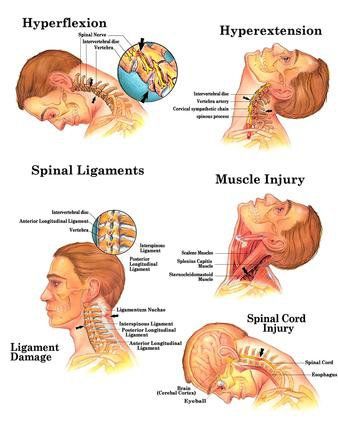Debilitating Whiplash in Jacksonville, FL
Whiplash in Jacksonville, FL:
Whiplash is a term that is used when car accidents or similar events cause the neck to move in a whip-like manner. The neck is suddenly jolted in different directions due to the acceleration and deceleration of the vehicle and or activity. Although it is normally seen after car accidents - a car accident injury, whiplash can be caused by injuries during sports, workplace accidents or falling.
What Happens to the Neck?
The severe neck pain felt after a whiplash injury is due to a strain of the muscles in the neck. There are ligaments that normally connect the vertebra to each other and offer general stability to the skeleton. If these ligaments are torn, it causes a sprain. There are also joints along the spine known as facet joints that can be affected by whiplash injuries. On occasion, individuals may experience a torn or herniated disc. The nerves around the vertebrae may become inflamed or stretched out (nerve traction injury). In severe cases, the vertebrae may even be fractured or dislocated by the crash.
Is it Possible to Prevent Whiplash?
Avoiding falls and injuries can prevent whiplash, but there is no technique to always prevent an injury. Car accidents and injuries are generally unexpected, which makes them difficult to prevent. Wearing a seat belt and setting the headrest in the car to the proper height can minimize the severity of potential injuries.
What Are the Symptoms of Whiplash?
Roughly two out of three people will experience whiplash symptoms following a car accident injury. The severity of the crash does not equate to the severity of the injury, although more severe injuries are often caused by worse crashes. Normally, the symptoms develop 2 to 48 hours after the accident although symptoms may arise even 2-4 weeks post injury. This is most likely caused by inflammation following the accident, delayed muscle soreness, and/or instability of the structure brought on by a ligamentous sprain.
- Neck pain (normally worse in areas that were hit first)
- Stiffness in the neck
- Severe pain and discomfort when neck is turned
- Headache on one or both sides of the head.
- Pain or Stiffness on the upper chest, shoulders, upper back and arms
- Blurred vision
- Dizziness, Vertigo, Nausea
- Problems swallowing
- Difficulty concentrating
How do Doctors Diagnose Whiplash?
At the beginning of the appointment, the doctor will look at the patient's entire medical history. They will consider pre-existing conditions like arthritis or a sports injury that may worsen the pain experienced by whiplash. Afterward, they examine the patient's neuro-musculoskeletal system. The doctor may perform an MRI or an X-ray to determine the extent of the injuries. Unfortunately, whiplash in Jacksonville, FL is a common occurrence.
How can Whiplash be Treated?
Although it seems counterintuitive, the first whiplash treatment is to stay active. Unless the patient is told not to move, they should continue to stretch, move and exercise. This will help the muscles to recover and become strong again.
Wearing a Cervical Collar / Neck Brace
For some individuals, the doctor may recommend a soft-cervical collar for whiplash treatment. This type of collar prevents the patient from moving their neck. The collar should not be an excuse to avoid physical activity unless the doctor ordered it. Patients should generally wear the soft-cervical collar for just a week or less. Afterward, their body can begin the self-healing process.
Injection Procedures and Surgical Operations
In severe cases of whiplash, an injection procedure or surgical operation may be appropriate. These treatment options are generally reserved for individuals who have sustained severe injuries to their nerves, discs and/or vertebrae in their neck. This may also be a good option once conservative management strategies have been exhausted.
Chiropractic Care and Physical Therapy
Ice and heat can help to limit the amount of pain experienced along with controlling inflammation. Physiotherapy techniques like therapeutic ultrasound or electrical muscle stimulation may also help to reduce pain, reduce inflammation and control muscle spasms. A chiropractor can perform spinal mobilization and manipulation to alleviate the pain.
Spinal adjusting helps restore the normal movement and function of the spinal joints and thus relaxes the injured, inflamed, spasmed muscles and soft tissues which will reduce pain and help aid proper healing. Research has shown that the sooner treatment is rendered the more positive the patient’s quality of life and long-term outcome is.

